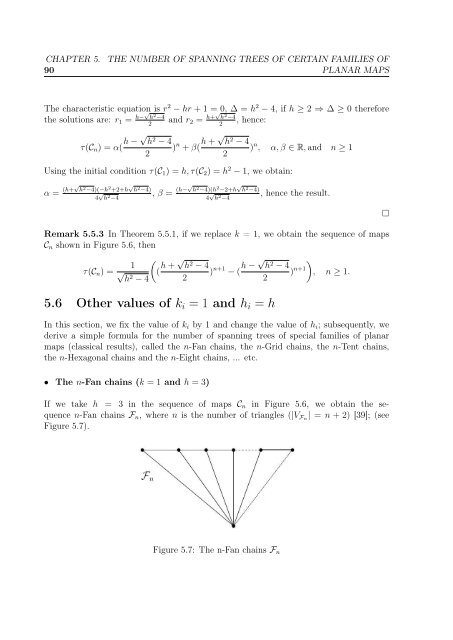enumeration of the number of spanning trees in some ... - Toubkal
enumeration of the number of spanning trees in some ... - Toubkal
enumeration of the number of spanning trees in some ... - Toubkal
Create successful ePaper yourself
Turn your PDF publications into a flip-book with our unique Google optimized e-Paper software.
CHAPTER 5.90THE NUMBER OF SPANNING TREES OF CERTAIN FAMILIES OFPLANAR MAPSThe characteristic equation is r 2 − hr + 1 = 0, ∆ = h 2 − 4, if h ≥ 2 ⇒ ∆ ≥ 0 <strong>the</strong>refore<strong>the</strong> solutions are: r 1 = h−√ h 2 −4and r2 2 = h+√ h 2 −4, hence:2τ(C n ) = α( h − √ h 2 − 42) n + β( h + √ h 2 − 4) n , α, β ∈ R, and n ≥ 12Us<strong>in</strong>g <strong>the</strong> <strong>in</strong>itial condition τ(C 1 ) = h, τ(C 2 ) = h 2 − 1, we obta<strong>in</strong>:α = (h+√ h 2 −4)(−h 2 +2+h √ h 2 −4)4 √ h 2 −4, β = (h−√ h 2 −4)(h 2 −2+h √ h 2 −4)4 √ , hence <strong>the</strong> result.h 2 −4□Remark 5.5.3 In Theorem 5.5.1, if we replace k = 1, we obta<strong>in</strong> <strong>the</strong> sequence <strong>of</strong> mapsC n shown <strong>in</strong> Figure 5.6, <strong>the</strong>nτ(C n ) =(1√h2 − 4( h + √ h 2 − 425.6 O<strong>the</strong>r values <strong>of</strong> k i = 1 and h i = h) n+1 − ( h − √ h 2 − 4)), n+1 n ≥ 1.2In this section, we fix <strong>the</strong> value <strong>of</strong> k i by 1 and change <strong>the</strong> value <strong>of</strong> h i ; subsequently, wederive a simple formula for <strong>the</strong> <strong>number</strong> <strong>of</strong> <strong>spann<strong>in</strong>g</strong> <strong>trees</strong> <strong>of</strong> special families <strong>of</strong> planarmaps (classical results), called <strong>the</strong> n-Fan cha<strong>in</strong>s, <strong>the</strong> n-Grid cha<strong>in</strong>s, <strong>the</strong> n-Tent cha<strong>in</strong>s,<strong>the</strong> n-Hexagonal cha<strong>in</strong>s and <strong>the</strong> n-Eight cha<strong>in</strong>s, ... etc.• The n-Fan cha<strong>in</strong>s (k = 1 and h = 3)If we take h = 3 <strong>in</strong> <strong>the</strong> sequence <strong>of</strong> maps C n <strong>in</strong> Figure 5.6, we obta<strong>in</strong> <strong>the</strong> sequencen-Fan cha<strong>in</strong>s F n , where n is <strong>the</strong> <strong>number</strong> <strong>of</strong> triangles (|V Fn | = n + 2) [39]; (seeFigure 5.7).Figure 5.7: The n-Fan cha<strong>in</strong>s F n

















